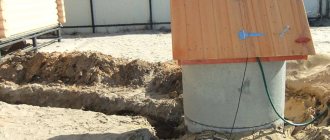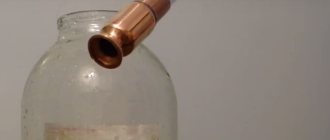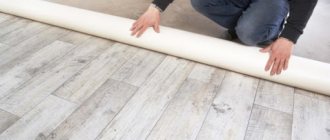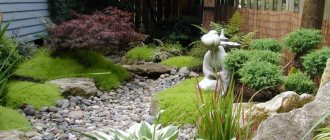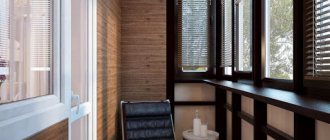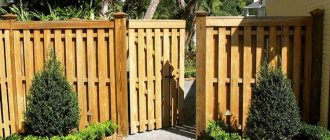A roof weather vane is a movable flag-shaped structure mounted on a rotating axis. The position changes depending on the direction of the wind. Mounted on houses or gazebos. Used to measure wind speed and strength, and also as a decorative decoration. You can do it yourself, the main thing is to correctly and accurately draw up a detailed drawing of the components with diagrams and a sketch.
Device
Most of the structure is stationary, only one axis rotates. The flag consists of the following parts:
- frame;
- bearing;
- rod(axis);
- cap and rubber lining;
- flag;
- counterweight.
The role of the body is played by a metal pipe with fasteners. It ensures the stability of the entire roof system. It contains a bearing and an axis that drive the wind vane - this is a metal flag that indicates the direction of the wind. A counterweight is necessary for balance.
The rubber lining makes the structure airtight so that precipitation does not get inside. An additional wind rose can be installed under the weather vane, which shows the direction of the parts of the world. It is fixed to the roof with clamps or plates.
Weather vanes for cat lovers
You can select silhouettes of arrows on the Arrows for weather vane page.
So, you have decided to decorate your country house with a weather vane. Which weather vane is better to choose? It is impossible to give universal advice here - who likes a proud dragon, and who prefers a ship. And some choose a figurine of a cat - a mysterious animal that sees in the dark and moves absolutely silently. A weather vane with a silhouette of a cat symbolizes home comfort and protects the house from the forces of evil. The cat symbolizes freedom and independence, as well as the forces of nature and supernatural abilities.
But the cat was not always considered a positive character. Different cultures treated cats very differently. In Egypt, it was revered as a sacred animal, and pharaohs were even buried with their personal embalmed cats. In ancient Rome, the goddess of freedom Libertas was depicted with a cat lying at her feet. In China they believe that a cat has 9 lives and is therefore a symbol of longevity. On the contrary, in medieval Europe the cat was considered a demonic creature, and there are quite a few drawings of witches with a black cat. The cat weathervane could not have appeared in such a culture, but in our time it has become very popular. It is chosen by freedom-loving people who are distinguished by their independent and proud character.
A more complex option is the flower pinwheel. “You wouldn't believe how well these weather vanes work - they spin even when you just walk past them. I love it so much!” - this is what Heather Bailey herself, its creator and developer, says about this toy. This fun weather vane was featured in scrapbooking magazine Keepsakes.
To make a flower pinwheel, we will need:
- 2 sheets of double-sided cardboard (18x18 cm);
- pieces of scrap paper to decorate the center of the pinwheel;
- decorative buttons;
- round bead with a diameter of approximately 1-1.5 cm;
- grommet (with a long leg);
- wire;
- narrow decorative tape;
- wooden stick.
Step 1: Print or trace the template twice onto double-sided cardstock and cut out two pieces. Make holes at the points indicated on the diagram (black dots along the edges and in the middle).
Step 2. Layer the cut pieces on top of each other and align them in the center, and then intertwine the petals of the pinwheel so that they alternate (see diagram). Glue these two parts in the area indicated on the template with a dotted circle, make a hole in the center of the circle and insert a grommet into it. Now each petal with a hole must be folded towards the center and threaded onto the eyelet leg. When all the petals are bent towards the middle, the grommet will need to be secured by flattening its stem.
Step 3. In the stick holder, drill a hole on one edge through which the pinwheel will be attached to the stick. Then wrap the stick with a narrow decorative ribbon and secure its edges to the stick with glue.
Step 4. Take the wire and, stepping back about 1 cm from the edge, make a bend at an angle of 90 degrees. Cut out two small circles from scrap paper or colored cardboard, and make a hole in the center of one of them. First put a circle with a hole on the bent end of the wire, and glue a circle without a hole on top of it so that the bent end of the wire is between the two circles. Thus, we made the part of the pinwheel on which the flower will spin - the spindle. Now you can decorate it at your discretion - cut out flowers from paper or glue decorative buttons and beads.
Step 5. Place a pinwheel flower on the spindle (wire with a flower), then a wooden bead. Thread the free edge of the wire into the hole on the sticks. Leaving a small gap between the bead and the stick, secure the wire to the sticks by wrapping the wire around it.
Source: https://heatherbailey.typepad.com
Weather vanes on the roof of the Big Cat in Moscow
Weather vane “Cat and Fox” 75 cm large metal for the roof of the house
Large weather vane “Cat”
Large weather vane "Cat"
Large weather vane “Cat and cat” 75 cm metal for the roof of the house
Weather vane "Cat and cat" 75 cm large metal for the roof of the house
Weather vane "Cat" large 800*600
TD "Ust-Luga" Small weather vane No. 5 "Cat"
Weather vane "Cats" large 800*600
Weather vane “Cats in love” 75 cm large metal for the roof of the house
TD "Ust-Luga" Weather vane No. 5 "Cat"
Weather vane “Cat with an arched back” 75 cm large metal for the roof of a house
Source
How to make an interesting wind generator with your own hands?
Making a weather vane with your own hands will first require solving two issues:
- design choice,
- choice of material.
In order to decide on the design of a weather vane, the easiest way is to look at photographs of various ready-made designs that are available on the Internet. Any photo gallery can give a visual representation of the variety of weather vanes and the abundance of opportunities for independent production.
Metal is the leading material. It is the most durable, durable and resistant to external influences. In addition, metal allows for different processing methods - forging, assembly with threaded connections, welding. The only weak point of the metal is corrosion that occurs on an unprotected steel surface.
Wooden structures are more affordable because they require tools that are available to almost any home craftsman. In addition, wood is easy to process and has a high degree of repairability. At the same time, the resistance to mechanical or physical impacts of such structures is much lower, and the operating conditions of such weather vanes do not allow them to exist for a long time.
The main element of the weather vane is the impeller (impeller), mounted on a traverse with a tail located at the opposite end. The center of gravity of the traverse is the installation point for the rotating mechanism, which allows it to rotate freely around its axis for trouble-free installation in the wind.
Placing the hinge at the balance point is very important, as this allows for the easiest rotation around a vertical axis in the direction of the wind, establishing the correct position of the impeller.
In terms of appearance, building a weather vane offers a lot of possibilities. There is a huge variety of design and constructive solutions that allow you to make an original and attractive weather vane that changes the appearance of the roof of the house and gives it a romantic look. Let's look at some types of weather vanes:
Without scissors
Surprisingly, you can make a “breeze” without using scissors. This, of course, will be more difficult and will take a little more time:
- Take whatman paper, cut out a square (paint it in the desired color).
- Fold it in half, bringing the corners together.
- Unfold - there will be a fold mark in the middle.
- Fold the edges on both sides to this mark again - you will get an elongated figure in the form of a “door” fold.
- This rectangle is folded in half so that the edges of the “door” are on the inside.
- Unfold back. Fold the edges of the figure to the fold line formed in the middle - you get a square in the form of a “door” fold.
- Unfold again - you will see that 2 small squares have formed at the ends.
- Bend each corner diagonally towards the “door” fold. Expand again.
- Along the existing fold, fold the workpiece in half into a square, divided by the marks of bending into four parts.
- Open the workpiece slightly and take the inner corner, pull it outward - a “breeze” blade will come out, as a result, all corners should be directed in one direction.
A paper pinwheel created using the origami technique is attached to a wooden stick in exactly the same way as any other.
Types and functions
Initially, the installation of a weather vane was carried out in order to monitor the direction of the wind. This information was most valuable in coastal cities, so windsocks began their march around the world from Holland. Later, the classic weather vane design was improved, supplemented and modified. All devices are divided into several groups:
- Meteorological instruments, which include the Wild weather vane, which determines the strength of the wind.
- A weather vane deflector is installed on the roof to protect the chimney pipe from blowing out and increase its draft.
- Decorative devices, which are characterized by a variety of designs. The choice of model is influenced by the material used in manufacturing and the tasks assigned to the weather vane.
The rather labor-intensive process of installation on the roof involves the use of durable metal structures. At the same time, homeowners are striving to install a windsock, which will become the hallmark of the house. To do this, interesting figures of birds, animals and fairy-tale characters are selected as a weather vane, among which the most common are:
- rooster;
- stork;
- Cat Cat);
- a lion;
- wolf;
- bear and others.
Attention!
Each figure on the roof has a certain meaning and is often chosen by the owner as a talisman for the house. In addition to roof decoration, there are many weather vanes made from less durable materials intended for other purposes. It is very practical to use structures made from plastic bottles to scare away birds or moles.
Rainbow
The rainbow pinwheel is made using 7 different colors, which is why it gets its name. To make it, you need to stock up on the following shades:
You will also need scissors, a needle, a hammer, paper clips, glue, a stick and a nail with a decorative head. The principle of attachment for the “rainbow” is the same as for other “winds”, but the blades are made according to a different principle:
- Cut out triangles of all available shades.
- The triangles must be absolutely identical: obtuse, isosceles.
- Place the triangle base up.
- Place the left corner on the top that is below and secure it with a paper clip.
- Do this with all triangles.
- Connect, glue and pierce the places where the paper clips are located with a nail.
- Nail the nail to the stick.
As this multi-colored “breeze” spins, it will look like a rainbow.
When your child makes a paper pinwheel for the first time with his own hands, you should definitely save a photo of it. After all, this is not the most durable material, and, most likely, the toy will break after a while. But if the child still has a photo, he will be able to repeat the product and even improve it.
See also:
Beautiful hand-made candlesticks will help you create an exquisite spiritual atmosphere. This decor will fill your home with warmth and comfort.
With imagination and skillful hands, you can make an unusual Christmas tree in a few minutes. It can be used as holiday decor or as an addition to a gift.
New Year's photos against a bare wall are strange. Against the background of a Christmas tree - it’s already better, but too ordinary. How to create a place where photographs will become small masterpieces even for non-professional photographers?
Where can I buy
If there is a blacksmith shop in your city, you simply cannot think of a better place for such an order - blacksmith masters will not only fulfill your order as quickly as possible, but will also take into account all individual wishes.
But if you are not interested in the little things, and you just want to buy a high-quality weather vane at a good price, contact the appropriate stores.
In addition, with the advent of the Internet, it became possible to order a product you like from another city in case you were not satisfied with the selection in the store.
Method 1: installation with universal mount
The universal mount allows you to install the weather vane on the ridge of a roof with any slope. To do this you need:
- Set the required angle at the fastening and screw it to the roof with self-tapping screws.
- Connect the two halves of the compass rose and bolt it to the stem.
- Complete the universal fastening with a reinforcing plate.
- Attach the rod to the universal mount, for which there is a special plate at its end.
- Insert the wind vane into the stem.
To prevent a metal bearing from rusting, it must be protected from moisture. To do this, additionally, before installing the weather vane, a special umbrella is mounted on the stem. Models with modern metal-graphite bearings do not need such protection.
Classic version of the “breeze”
The turntable is otherwise called a “breeze” or a mini-weather vane, because it spins under the influence of the wind. To make it, you will need the simplest things:
- scissors,
- simple pencil,
- cardboard,
- ruler,
- PVA glue,
- small carnation
- wooden stick,
- hammer.
First you need to cut out an even square. If it does not turn out that way, the weather vane will not spin. What do they do next?
- Bend diagonally in one direction and the other to mark the location of the future cut.
- From the intersection of these lines, you need to measure 1-2 cm using a ruler, depending on the size of the product, and write a note with a pencil.
- Using scissors, cut along the folds to the note.
- It turned out to be 4 interconnected triangles.
- Glue the upper left edge of each triangle to the center.
When all the corners are in the center, you need to pierce the product with a nail in the middle and nail the nail to the edge of the piece of wood (you can take a tree branch, long pencils, even a sushi stick). Just not too close, otherwise the mini-vane will not spin.
This is the easiest way to make a paper pinwheel. To make it bright on both sides, you can glue two different colors together: on one side - plain, and on the other - with a pattern. This way the “breeze” will look more voluminous.
